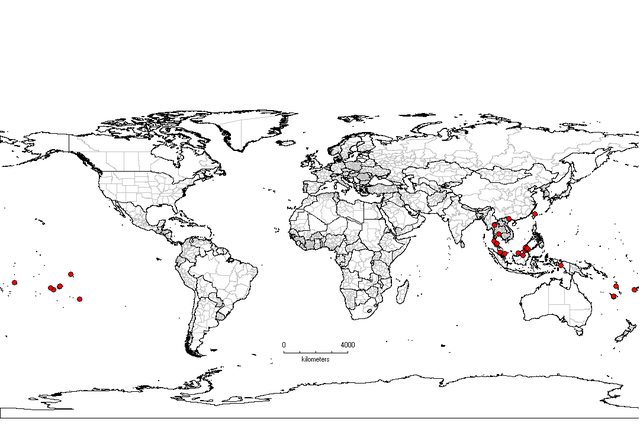Nomenclature
Ipomoea batatas (L.) Lam., Encycl. 1: 465. 1793.
Convolvulus batatas L., Sp. Pl. 1: 154. 1753
Batatas edulis (Thunberg ex Murray) Choisy
C. candicans Solander ex Sims
C. edulis Thunberg ex Murray, Fl. Jap. 84. 1784.
Ipomoea batatas (L.) Lamarck var. edulis (Thunberg ex Murray) Makino
I. batatas var. lobata Gagnepain & Courchet
I. edulis (Thunberg ex Murray) Makino
I. fastigiata Sweet.
Batatas edulis (Thunb.) Choisy, Mém. Soc. Phys. Genève 6: 435. 1834.
Description
Fang R.C., G. Staples, et al. 1995. Convolvulaceae in P. Raven & C.Y. Wu (eds.) Flora of China 16: 271–325.
Cytology
Fang R.C., G. Staples, et al. 1995. Convolvulaceae in P. Raven & C.Y. Wu (eds.) Flora of China 16: 271–325.
Biogeography, Ecology and Natural History

Originally developed in tropical America; now grown worldwide.
China: Cultivated
as a food plant and commercial crop, sometimes persisting from cultivation, but
doubtfully naturalized.
Thailand: Grown
in home gardens and agricultural fields, sometimes persisting from cultivation;
altitude: 5 m and up.
Flowering: January, December.
Fang R.C., G. Staples, et al. 1995. Convolvulaceae in P. Raven & C.Y. Wu (eds.) Flora of China 16: 271–325.
Staples, G. 2010. Convolvulaceae. Fl. Thailand 10(3): 330–468.
Other information
Ipomoea batatas is a productive and adaptable crop. Its tubers are an important source of food, starch, and raw material for producing alcohol. The stems and leaves can be used as livestock forage.
Plants may persist for several years after cultivation ceases. An extensive cultivar nomenclature exists to accommodate the numerous shapes, colours, and sizes of storage organs. Several cultivars with coloured foliage are now sold as ornamentals in the nursery trade.
Authorship for webpage


Add new comment